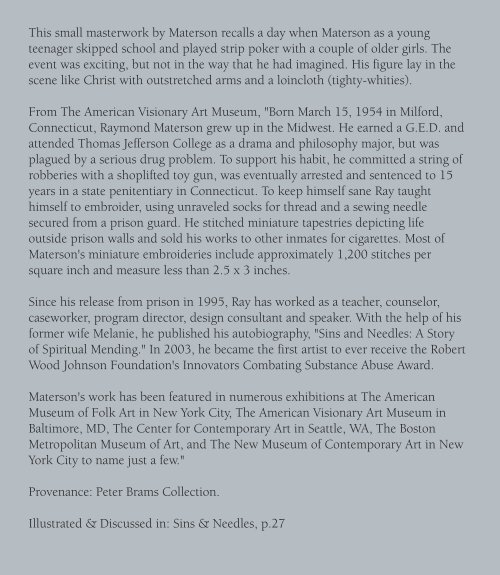Shut The Door And Listen From Outside
Steven S. Powers / Winter 2020 Catalog "Shut The Door And Listen From Outside" is a statement from Oblique Strategies, which is a set of cards each with a suggestion, directive, or constraint created by the artists Brian Eno and Peter Schmidt to encourage lateral thinking and to break creative blocks. With this in mind, as an art dealer or collector, one may think, how will this look if I see it indirectly? From a room away? Through a window? Obscured through a crowd of people? Or as I quickly scroll through Instagram? This question is not a shallow proposition—we often see a particular artwork from an off-angle or perspective—not in optimal presentation. Indeed, if we think about it, we likely first approached an artwork we came to love because it looked good "from outside." It had something special going on from a small section we gleaned through a crowd of people, or the composition came into focus as we came towards it from another room. As an artist, we may interpret this as another way of seeing. To purposely not see clearly or overtly—to create something anew based on partial information or hazy suggestions seen or heard. Or another way to look at a work in progress. View it from the side, across the room, or without glasses to see a fuzzy tonal map—does it still work for you?
Steven S. Powers / Winter 2020 Catalog
"Shut The Door And Listen From Outside" is a statement from Oblique Strategies, which is a set of cards each with a suggestion, directive, or constraint created by the artists Brian Eno and Peter Schmidt to encourage lateral thinking and to break creative blocks.
With this in mind, as an art dealer or collector, one may think, how will this look if I see it indirectly? From a room away? Through a window? Obscured through a crowd of people? Or as I quickly scroll through Instagram? This question is not a shallow proposition—we often see a particular artwork from an off-angle or perspective—not in optimal presentation. Indeed, if we think about it, we likely first approached an artwork we came to love because it looked good "from outside." It had something special going on from a small section we gleaned through a crowd of people, or the composition came into focus as we came towards it from another room.
As an artist, we may interpret this as another way of seeing. To purposely not see clearly or overtly—to create something anew based on partial information or hazy suggestions seen or heard. Or another way to look at a work in progress. View it from the side, across the room, or without glasses to see a fuzzy tonal map—does it still work for you?
Create successful ePaper yourself
Turn your PDF publications into a flip-book with our unique Google optimized e-Paper software.
This small masterwork by Materson recalls a day when Materson as a young<br />
teenager skipped school and played strip poker with a couple of older girls. <strong>The</strong><br />
event was exciting, but not in the way that he had imagined. His figure lay in the<br />
scene like Christ with outstretched arms and a loincloth (tighty-whities).<br />
<strong>From</strong> <strong>The</strong> American Visionary Art Museum, "Born March 15, 1954 in Milford,<br />
Connecticut, Raymond Materson grew up in the Midwest. He earned a G.E.D. and<br />
attended Thomas Jefferson College as a drama and philosophy major, but was<br />
plagued by a serious drug problem. To support his habit, he committed a string of<br />
robberies with a shoplifted toy gun, was eventually arrested and sentenced to 15<br />
years in a state penitentiary in Connecticut. To keep himself sane Ray taught<br />
himself to embroider, using unraveled socks for thread and a sewing needle<br />
secured from a prison guard. He stitched miniature tapestries depicting life<br />
outside prison walls and sold his works to other inmates for cigarettes. Most of<br />
Materson's miniature embroideries include approximately 1,200 stitches per<br />
square inch and measure less than 2.5 x 3 inches.<br />
Since his release from prison in 1995, Ray has worked as a teacher, counselor,<br />
caseworker, program director, design consultant and speaker. With the help of his<br />
former wife Melanie, he published his autobiography, "Sins and Needles: A Story<br />
of Spiritual Mending." In 2003, he became the first artist to ever receive the Robert<br />
Wood Johnson Foundation's Innovators Combating Substance Abuse Award.<br />
Materson's work has been featured in numerous exhibitions at <strong>The</strong> American<br />
Museum of Folk Art in New York City, <strong>The</strong> American Visionary Art Museum in<br />
Baltimore, MD, <strong>The</strong> Center for Contemporary Art in Seattle, WA, <strong>The</strong> Boston<br />
Metropolitan Museum of Art, and <strong>The</strong> New Museum of Contemporary Art in New<br />
York City to name just a few."<br />
Provenance: Peter Brams Collection.<br />
Illustrated & Discussed in: Sins & Needles, p.27


